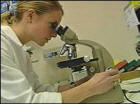What is tissue typing?
It really requires a highly tuned
medical or scientific brain to understand tissue typing!
The first point to make is the
easiest one to understand, and it is this: Matching a
potential bone marrow donor to a patient has nothing to do with
blood type. And that is an important point to understand.
Whereas there are several different "blood types" there are tens
of thousands of different possible "tissue types".

Are you ready for it to get
complicated? If you are, then read on.
The difficulty in
finding a suitable donor lies in the fact that the donor's and
patient's "tissue type" must closely match in order for the
transplant to be successful. Genetic markers on the
surface of white blood cells called HLA-antigens define a
person's tissue type. Since these genetic markers are
inherited, siblings are much more likely to have similar HLA-antigens
than unrelated persons.
There's about a 30
percent chance that a patient's sibling will be a suitable
donor. (i.e. a one-in-four chance of any one sibling being a
match, with increased odds in larger families). If a donor must
be located in the general population, the chances of finding a
match range from one in 1,000 to one in several million,
depending on the frequency of the patient's tissue type in the
general population.
And that is about enough for me to
take in. How about you? A key point is that it is an
incredibly specialised as well as complex issue. It
involves white cells, chromosomes and DNA testing.
If you have an appetite for this
sort of stuff the
follow this link to
delve deeper!